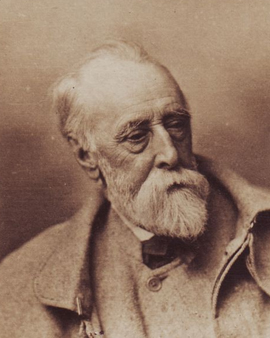In 18th-century England, industrialisation had already made great strides and shaped the social structure. The bourgeoisie had become more differentiated, and with it a self-confident and independent artistic scene. Artists like Turner had taken up the styles of the continent and given them their own form. This development continued in the 19th century. George Friedrich Watts' development as an artist coincided with an epoch when the lightness of Impressionism and the naturalistic depictions were coming to an end. In England a counter-movement developed, which Watts followed. Symbolism wanted to tie in with earlier epochs in which mystical-religious themes determined the composition of the pictures. The visual language became symbolic and the viewer was asked to understand the symbols in order to interpret the entire work.
"I paint ideas and not things" said George Friedrich Watts about his works and aimed to portray emotions and the aspirations of life in a universal and symbolic visual language. Watts preferred allegories and these made him famous even during his lifetime. Some depictions seem abstract. The Sower often he Systems shows a representation of God consisting of a veil of stars and. The influence of the emerging romanticism is visible. However, while the Romantics convey a positive mood, the Symbolists tend to be pessimistic, and Watts was considered a great talent by his fellow artists and received great respect. Paintings from which a light shone that took up the entire canvas and included the shadows made painters look up to Watts with almost reverence. The painter created large canvases in a blaze of colour reminiscent of the old masters of Italy. Michelangelo's works had made a strong impression on Watts and he would have liked to establish this art in his native England. Unfortunately, Watts lacked financial means and he did not consider himself to be sufficiently talented.
George Friedrich Watts' effect on others and his self-assessment are ambivalent. Contemporaries describe the painter as charismatic and pleasant. He had a reputation as a genius and was a welcome participant in the literary salons of Little Holland House. The Prinsep family household became Watts' home for a long time. A three-day visit turned into a three-year stay. The artist was given the status of a family member and had an intimate relationship with the family. Especially one sister of Sara Prinsep triggered deep feelings in him. Watts painted a portrait of Virginia that couldn't have been more graceful to conjure up the beauty of the woman, and although Virginia returned the artist's feelings and was a regular guest in his studio, Watt did not reveal himself to her. Too inferior was the assessment of his own person. Fate continued its cruel course. A second portrait was in the studio and the visit of a viscount led to the guest falling in love with Virginia, proposing to her and finally getting married.
×





.jpg)
.jpg)
.jpg)
.jpg)
.jpg)
.jpg)
.jpg)
.jpg)
.jpg)
.jpg)
.jpg)
.jpg)
.jpg)
.jpg)
.jpg)
.jpg)
.jpg)
.jpg)
_-_(MeisterDrucke-601974).jpg)
_-_(MeisterDrucke-601974).jpg)
_-_(MeisterDrucke-551652).jpg)
_-_(MeisterDrucke-551652).jpg)
_-_(MeisterDrucke-903278).jpg)
_-_(MeisterDrucke-903278).jpg)
.jpg)
.jpg)
.jpg)
.jpg)
.jpg)
.jpg)
 c1864 (oil on strawboard) - (MeisterDrucke-69190).jpg)
 c1864 (oil on strawboard) - (MeisterDrucke-69190).jpg)
_1867_-_(MeisterDrucke-36598).jpg)
_1867_-_(MeisterDrucke-36598).jpg)
.jpg)
.jpg)
.jpg)
.jpg)
.jpg)
.jpg)
_-_(MeisterDrucke-323582).jpg)
_-_(MeisterDrucke-323582).jpg)
.jpg)
.jpg)
.jpg)
.jpg)
.jpg)
.jpg)
 - (MeisterDrucke-275951).jpg)
 - (MeisterDrucke-275951).jpg)
.jpg)
.jpg)
 Viscount Stratford de Redcliffe (1856-7) - (MeisterDrucke-78888).jpg)
 Viscount Stratford de Redcliffe (1856-7) - (MeisterDrucke-78888).jpg)
.jpg)
.jpg)
.jpg)
.jpg)
.jpg)
.jpg)
.jpg)
.jpg)
.jpg)
.jpg)
_-_(MeisterDrucke-902741).jpg)
_-_(MeisterDrucke-902741).jpg)
.jpg)
.jpg)
.jpg)
.jpg)
 - (MeisterDrucke-209636).jpg)
 - (MeisterDrucke-209636).jpg)
 - (MeisterDrucke-129841).jpg)
 - (MeisterDrucke-129841).jpg)
 1898 - (MeisterDrucke-83739).jpg)
 1898 - (MeisterDrucke-83739).jpg)
 - (MeisterDrucke-231245).jpg)
 - (MeisterDrucke-231245).jpg)
.jpg)
.jpg)
.jpg)
.jpg)
.jpg)
.jpg)
.jpg)
.jpg)
.jpg)
.jpg)
.jpg)
.jpg)
_-_(MeisterDrucke-316284).jpg)
_-_(MeisterDrucke-316284).jpg)
.jpg)
.jpg)
.jpg)
.jpg)
.jpg)
.jpg)
.jpg)
.jpg)
_-_(MeisterDrucke-319332).jpg)
_-_(MeisterDrucke-319332).jpg)
.jpg)
.jpg)
.jpg)
.jpg)
.jpg)
.jpg)
.jpg)
.jpg)
.jpg)
.jpg)
.jpg)
.jpg)
 - (MeisterDrucke-202540).jpg)
 - (MeisterDrucke-202540).jpg)
.jpg)
.jpg)
.jpg)
.jpg)
 - (MeisterDrucke-184834).jpg)
 - (MeisterDrucke-184834).jpg)
.jpg)
.jpg)
.jpg)
.jpg)
.jpg)
.jpg)
.jpg)
.jpg)
.jpg)
.jpg)
.jpg)
.jpg)
.jpg)
.jpg)
.jpg)
.jpg)
_-_(MeisterDrucke-431735).jpg)
_-_(MeisterDrucke-431735).jpg)
.jpg)
.jpg)
.jpg)
.jpg)
.jpg)
.jpg)
.jpg)
.jpg)
.jpg)
.jpg)
.jpg)
.jpg)
.jpg)
.jpg)
.jpg)
.jpg)
.jpg)
.jpg)
.jpg)
.jpg)
.jpg)
.jpg)
.jpg)
.jpg)
.jpg)
.jpg)
.jpg)
.jpg)
_-_(MeisterDrucke-431733).jpg)
_-_(MeisterDrucke-431733).jpg)
.jpg)
.jpg)
.jpg)
.jpg)
.jpg)
.jpg)
.jpg)
.jpg)
.jpg)
.jpg)
.jpg)
.jpg)
.jpg)
.jpg)
.jpg)
.jpg)
.jpg)
.jpg)
.jpg)
.jpg)
.jpg)
.jpg)
.jpg)
.jpg)
.jpg)
.jpg)
.jpg)
.jpg)
.jpg)
.jpg)






